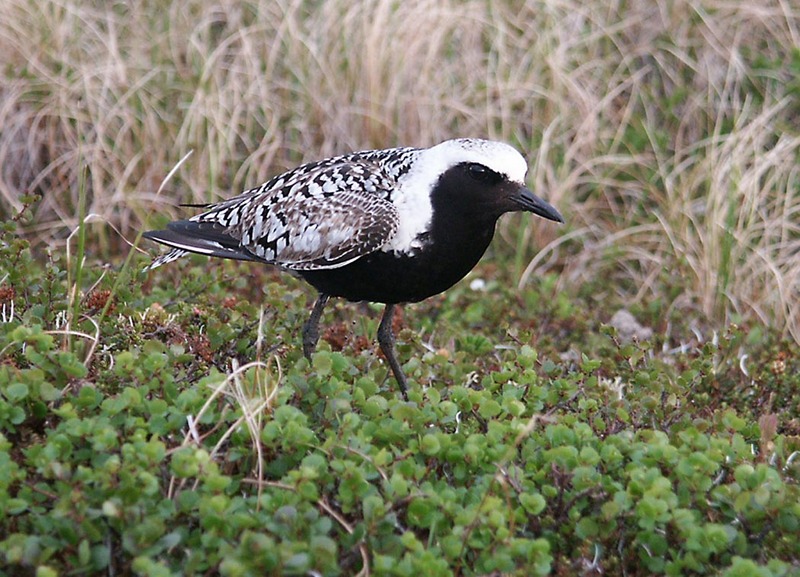|
| Query: birds of america | Result: 647th of 1888 | |
Grey Plover (Pluvialis squatarola) - Wiki
| Subject: | Grey Plover (Pluvialis squatarola) - Wiki
| |

| Resolution: 1050x757
File Size: 193912 Bytes
Date: 2004:06:01 15:59:55
Camera: DiMAGE 7Hi (Minolta Co., Ltd.)
F number: f/3.4
Exposure: 1/180 sec
Focal Length: 12872/256
Upload Date: 2007:10:01 16:41:41
|
Grey Plover
From Wikipedia, the free encyclopedia
[Photo] Black-bellied Plover (Pluvialis squatarola). Adult in summer plumage on tundra breeding grounds. Creator: Tim Bowman. Source: Fish and Wildlife Service (public domain)
The Grey Plover (Pluvialis squatarola), known as the Black-bellied Plover in North America, is a medium-sized plover breeding in arctic regions. It is a long-distance migrant, with a nearly world-wide coastal distribution when not breeding.
They are 27???30 cm long with a wingspan of 71???83 cm, and a weight of 190???280 g (up to 345 g in preparation for migration). In spring and summer (late April or May to August), the adults are spotted black and white on the back and wings. The face and neck are black with a white border; they have a black breast and a white rump. The tail is white with black barring. The bill and legs are black. They moult to winter plumage in mid August to early September and retain this until April; this being a fairly plain grey above, with a grey-speckled breast and white belly. The juvenile and first-winter plumages, held by young birds from fledging until about one year old, are similar to the adult winter plumage but with the back feathers blacker with creamy white edging. In all plumages, the inner flanks and axillary feathers at the base of the underwing are black, a feature which readily distinguishes it from the other three Pluvialis species in flight. On the ground, it can also be told from the other Pluvialis species by its larger (24???34 mm), heavier bill.
Their breeding habitat is Arctic islands and coastal areas across the northern coasts of Alaska, Canada, and Russia. They nest on the ground in a dry open tundra with good visibility; the nest is a shallow gravel scrape. Four eggs (sometimes only three) are laid in early June, with an incubation period of 26???27 days; the chicks fledge when 35???45 days old.
They migrate to winter in coastal areas nearly throughout the world. In the New World they winter from southwest British Columbia and Massachusetts south to Argentina and Chile, in the western Old World from Britain and southwestern Norway south throughout coastal Africa to South Africa, and in the eastern Old World, from southern Japan south throughout coastal southern Asia and Australia, with a few reaching New Zealand. It makes regular non-stop transcontinental flights over Asia, Europe, and North America, but is mostly a rare vagrant on the ground in the interior of continents, only landing occasionally if forced down by severe weather, or to feed on the coast-like shores of very large lakes such as the Great Lakes, where it is a common passage migrant.
Young birds do not breed until two years old; they typically remain on the wintering grounds until their second summer.
They forage for food on beaches and tidal flats, usually by sight. The food consists of small molluscs, polychaete worms, crustaceans, and insects. It is less gregarious than the other Pluvialis species, not forming dense feeding flocks, instead feeding widely dispersed over beaches, with birds well spaced apart. They will however form dense flocks on high tide roosts.
The Grey Plover is one of the species to which the Agreement on the Conservation of African-Eurasian Migratory Waterbirds (AEWA) applies.
http://en.wikipedia.org/wiki/Grey_Plover
| The text in this page is based on the copyrighted Wikipedia article shown in above URL. It is used under the GNU Free Documentation License. You may redistribute it, verbatim or modified, providing that you comply with the terms of the GFDL. |
|
^o^
Animal Pictures Archive for smart phones
^o^
|
|

